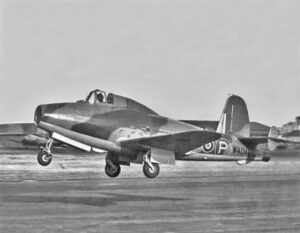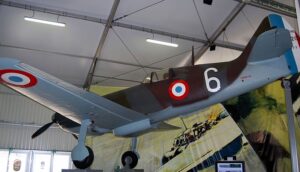Time Period: Interwar Period, World War II
Country of Origin: United Kingdom
Type: Fighter Aircraft, Biplane
Manufacturer: Gloster
Gloster Gladiator Aircraft Overview
The Gloster Gladiator was a British single-seat biplane fighter aircraft that was used by the Royal Air Force (RAF) and the Fleet Air Arm (FAA) during the late 1930s and early 1940s. It was the last biplane fighter to be used by the RAF and was quickly overshadowed by the introduction of monoplane fighters.
The Gladiator was designed by the Gloster Aircraft Company in the mid-1930s as a response to a requirement by the RAF for a modern fighter aircraft. It was a development of an earlier biplane design called the Gauntlet and featured a metal fuselage and fabric-covered wings. It was powered by a Bristol Mercury radial engine and had an open cockpit for the pilot.
The Gladiator was armed with four .303-inch machine guns and could also carry bombs or rockets under the wings. It was used by the RAF in several theaters of war, including North Africa, where it saw significant action against Italian forces. It was also used by the FAA aboard aircraft carriers.
Although the Gladiator was slower and less maneuverable than contemporary monoplane fighters, it was still able to hold its own in combat due to its ruggedness and reliability. It was eventually replaced in RAF service by more modern monoplane fighters like the Hawker Hurricane and Supermarine Spitfire, but it continued to see service in other air forces around the world.
Gloster Gladiator Specifications
- Crew: 1
- Length: 27 ft 5 in (8.36 m)
- Wingspan: 32 ft 3 in (9.83 m)
- Height: 11 ft 9 in (3.58 m)
- Wing area: 323 sq ft (30.0 m2)
- Airfoil: RAF 28
- Empty weight: 3,217 lb (1,459 kg)
- Gross weight: 4,594 lb (2,084 kg)
- Powerplant: 1 × Bristol Mercury IX 9-cylinder air-cooled radial piston engine, 830 hp (620 kW)
- Propellers: 3-bladed fixed-pitch metal propeller
Gloster Gladiator Performance
- Maximum speed: 253 mph (407 km/h, 220 kn) at 14,500 ft (4,420 m)
- Cruise speed: 210 mph (340 km/h, 180 kn)
- Stall speed: 53 mph (85 km/h, 46 kn)
- Endurance: 2 hours
- Service ceiling: 32,800 ft (10,000 m)
- Rate of climb: 2,300 ft/min (12 m/s)
- Time to altitude: 10,000 ft (3,048 m) in 4 minutes 45 seconds
Gloster Gladiator Armament
- Guns:
-
- Initially; Two synchronized .303 in Vickers machine guns on fuselage sides, and two .303 in Lewis guns; one beneath each lower wing.
- Later aircraft; Four .303 caliber M1919 Browning machine guns; two synchronized guns in fuselage sides and one beneath each lower wing.
Gloster Gladiator Image Gallery
More Gloster Aircraft

Gloster F.5/34
The Gloster F.5/34 was a British single-seat, single-engine monoplane fighter aircraft with eight machine guns and an air-cooled engine.

Gloster Meteor
The Gloster Meteor was the first British jet engine and the only one used by the Allies during the Second World War.

Gloster E.28/39
The Gloster E.28/39, first flown in 1941, was the first British jet-engine aircraft and the fourth jet to fly. It led to the Gloster Meteor.










